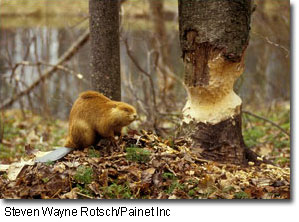American Beaver
(Castor canadensis)
 Description & Range:
Description & Range:
Beavers are the largest rodents in North America and the second largest rodent in the world. Beavers can weigh from 30-60 pounds and can get up to 40 inches in length (including their tail). Their body is covered with thick, reddish-brown fur. Beavers have hairless, paddle-shaped tails that are used for steering when swimming. Beavers also store fat in their tails for the winter and slap their tails against the water to warn other beavers of potential predators.
Beavers were hunted almost to extinction in the mid-1800s. However, beavers are now common throughout Maryland and the rest of the United States.
Habitat:
Beavers live near rivers, streams, ponds, small lakes and marshes. Beavers cut down small-medium trees to dam up streams and rivers to create ponds. One beaver can cut down 216 trees in a year. Beavers live in lodges which include a feeding den, a resting den, a source of fresh air and two underwater entrance tunnels, which allow for a means of escape if a predator enters the lodge.
Diet:
Beavers are herbivores, and their diet changes with the seasons. During the winter months, beavers prefer woody vegetation such as sweet gum, ash, willows, poplar, cottonwoods, pines and fruit trees. In the spring and summer, beaver tend to eat lush aquatic plants and shoots of young plants. Beavers, like other rodents, have incisors that continue to grow throughout their life.
Reproduction:
Beavers are monogamous, meaning they have one mate for the breeding season and usually for life. Beavers breed in midwinter and, after a gestation period of 100 to 110 days, a single litter of two to five kits is born in May or early June. At birth, the kits possess fully developed teeth and lots of fur. At two to three weeks of age the kits begin to eat vegetation and are weaned by about six weeks. The young remain with the adults as a family group or colony until their second year.
Sounds:
Beavers make several sounds such as churrs, mumbles, whines, snorts and hisses. They also will slap their tail against the water to sound an alarm to other beavers and to warn other animals.
Behavior:
Beavers are social animals that tend to live in colonies consisting of a breeding pair and two generations of their offspring. Once the young, called kits, reach two years old, they are driven out of the colony to find their own territory. Beavers mark their territories with musk from their scent glands. Beavers are active from dusk until dawn.
Did You Know?
Beavers have transparent eyelids that help them see while swimming underwater. Beavers also can close up their ears and nose to prevent water from getting in while swimming underwater. Beavers also use their large black claws to groom their coats.
Beavers are managed as furbearers in Maryland. For more information on furbearer management, please click here.